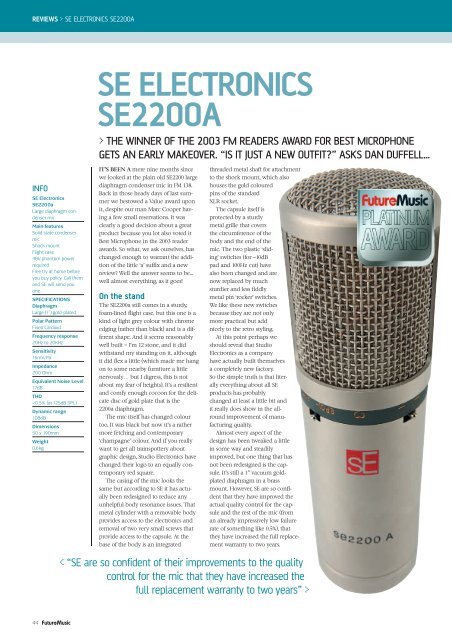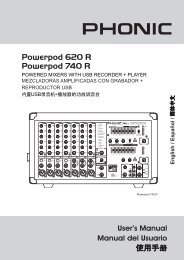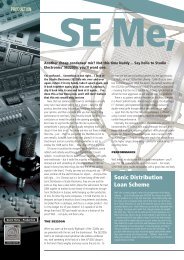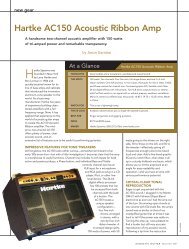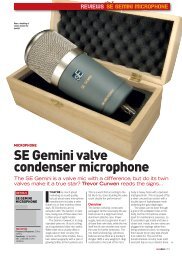SE ELECTRONICS SE2200A
SE ELECTRONICS SE2200A
SE ELECTRONICS SE2200A
You also want an ePaper? Increase the reach of your titles
YUMPU automatically turns print PDFs into web optimized ePapers that Google loves.
FMU150.g_semic 20/5/04 4:37 pm Page 44<br />
REVIEWS > <strong>SE</strong> <strong>ELECTRONICS</strong> <strong>SE</strong>2200A<br />
£149<br />
INFO<br />
<strong>SE</strong> Electronics<br />
<strong>SE</strong>2200a<br />
Large diaphragm condenser<br />
mic<br />
Main features<br />
Solid state condenser<br />
mic<br />
Shock mount<br />
Flight case<br />
48V phantom power<br />
required<br />
Free try at home before<br />
you buy policy. Call them<br />
and <strong>SE</strong> will send you<br />
one.<br />
SPECIFICATIONS<br />
Diaphragm<br />
Large (1”) gold-plated<br />
Polar Pattern<br />
Fixed Cardioid<br />
Frequency response<br />
20Hz to 20kHz<br />
Sensitivity<br />
16mV/ Pa<br />
Impedance<br />
200 Ohm<br />
Equivalent Noise Level<br />
17dB<br />
THD<br />
THE WINNER OF THE 2003 FM READERS AWARD FOR BEST MICROPHONE<br />
GETS AN EARLY MAKEOVER. “IS IT JUST A NEW OUTFIT?” ASKS DAN DUFFELL…<br />
IT’S BEEN A mere nine months since<br />
we looked at the plain old <strong>SE</strong>2200 large<br />
diaphragm condenser mic in FM 138.<br />
Back in those heady days of last summer<br />
we bestowed a Value award upon<br />
it, despite our man Marc Cooper having<br />
a few small reservations. It was<br />
clearly a good decision about a great<br />
product because you lot also voted it<br />
Best Microphone in the 2003 reader<br />
awards. So what, we ask ourselves, has<br />
changed enough to warrant the addition<br />
of the little ‘a’ suffix and a new<br />
review? Well the answer seems to be...<br />
well almost everything, as it goes!<br />
On the stand<br />
The <strong>SE</strong>2200a still comes in a sturdy,<br />
foam-lined flight case, but this one is a<br />
kind of light grey colour with chrome<br />
edging (rather than black) and is a different<br />
shape. And it seems reasonably<br />
well built – I’m 12 stone, and it did<br />
withstand my standing on it, although<br />
it did flex a little (which made me hang<br />
on to some nearby furniture a little<br />
nervously… but I digress, this is not<br />
about my fear of heights). It’s a resilient<br />
and comfy enough cocoon for the delicate<br />
disc of gold plate that is the<br />
2200a diaphragm.<br />
The mic itself has changed colour<br />
too. It was black but now it’s a rather<br />
more fetching and contemporary<br />
‘champagne’ colour. And if you really<br />
want to get all trainspottery about<br />
graphic design, Studio Electronics have<br />
changed their logo to an equally contemporary<br />
red square.<br />
The casing of the mic looks the<br />
same but according to <strong>SE</strong> it has actually<br />
been redesigned to reduce any<br />
unhelpful body resonance issues. That<br />
metal cylinder with a removable body<br />
provides access to the electronics and<br />
removal of two very small screws that<br />
provide access to the capsule. At the<br />
base of the body is an integrated<br />
threaded metal shaft for attachment<br />
to the shock mount, which also<br />
houses the gold coloured<br />
pins of the standard<br />
XLR socket.<br />
The capsule itself is<br />
protected by a sturdy<br />
metal grille that covers<br />
the circumference of the<br />
body and the end of the<br />
mic. The two plastic ‘sliding’<br />
switches (for –10dB<br />
pad and 100Hz cut) have<br />
also been changed and are<br />
now replaced by much<br />
sturdier and less fiddly<br />
metal pin ‘rocker’ switches.<br />
We like these new switches<br />
because they are not only<br />
more practical but add<br />
nicely to the retro styling.<br />
At this point perhaps we<br />
should reveal that Studio<br />
Electronics as a company<br />
have actually built themselves<br />
a completely new factory.<br />
So the simple truth is that literally<br />
everything about all <strong>SE</strong><br />
products has probably<br />
changed at least a little bit and<br />
it really does show in the allround<br />
improvement of manufacturing<br />
quality.<br />
Almost every aspect of the<br />
design has been tweaked a little<br />
in some way and steadily<br />
improved, but one thing that has<br />
not been redesigned is the capsule.<br />
It’s still a 1” vacuum goldplated<br />
diaphragm in a brass<br />
mount. However, <strong>SE</strong> are so confident<br />
that they have improved the<br />
actual quality control for the capsule<br />
and the rest of the mic (from<br />
an already impressively low failure<br />
rate of something like 0.5%), that<br />
they have increased the full replacement<br />
warranty to two years.<br />
< “<strong>SE</strong> are so confident of their improvements to the quality<br />
control for the mic that they have increased the<br />
full replacement warranty to two years” ><br />
44 FutureMusic
FMU150.g_semic 20/5/04 4:37 pm Page 45<br />
<strong>SE</strong> <strong>ELECTRONICS</strong> <strong>SE</strong>2200A < REVIEWS<br />
THE MOUNT POLICE<br />
If you are a regular FM<br />
reader you may have<br />
spotted that actually<br />
causing a product to break<br />
during a review is a rare<br />
thing these days (even<br />
though we genuinely do<br />
try!). Not only did Marc<br />
Cooper manage to break the<br />
original shock mount for the<br />
<strong>SE</strong>2200, he managed to break<br />
the replacement too, which<br />
indicates a bit of a design or<br />
manufacturing problem.<br />
He also found a poor standard<br />
of finishing with some sharp<br />
edges in evidence. This has all<br />
been resolutely addressed with the<br />
new 2200a, and it comes with an<br />
absolute beast of a mount. The<br />
threaded mounting ring that secures<br />
the mic to the cradle holds the mic<br />
very firmly in place and has a felt<br />
damping ring.<br />
The cradle itself is suspended by<br />
two easily replaceable elasticised<br />
cords. The actual stand bracket does<br />
now have a supplied adaptor (5/8-<br />
inch to 3/8-inch) and the wing nut<br />
holds it extremely securely at your<br />
chosen angle. In deference to the<br />
breakage issue (and not wanting to<br />
miss out on the fun) I did my level<br />
best to break this mount and failed<br />
miserably, which is always reassuring<br />
to know!<br />
In use<br />
The <strong>SE</strong>2200a is one of those products<br />
that makes you think twice and then<br />
three times about what you expect to<br />
hear when you look at its price tag. I<br />
tried it with a very broad range of stuff<br />
from vocals (male and female) to<br />
acoustic guitar, piano and various types<br />
of percussion and it delivered clean,<br />
crisp results every time. It has an open,<br />
lively and most pleasing tone and performs<br />
very well right across the frequency<br />
spectrum, and it should serve<br />
you very well, regardless of the scale<br />
and sophistication of your studio.<br />
That said, it’s not 100% flat right<br />
across the board, but then you<br />
wouldn’t expect that at the price. The<br />
relatively low Equivalent Noise Level<br />
and high maximum SPL also mean<br />
that not only does the <strong>SE</strong>2200a tolerate<br />
very loud sound sources but it captures<br />
more detail than most humans can<br />
actually hear (without clouding it<br />
with self-generated noise), delivering<br />
a better dynamic range than 16-bit digital<br />
audio recording can translate. The<br />
100Hz cut switch works, but still only<br />
seems to roll off about 6dB (compared<br />
The rather fetching flight case can even<br />
cope with being stomped on by journalists<br />
><br />
to my mixer’s 18dB) and for my personal<br />
taste is set a little high – around<br />
70-80Hz being more to my liking.<br />
Numbers game<br />
It’s worth mentioning that the <strong>SE</strong>2200a<br />
returns a somewhat different frequency<br />
response with its two level settings.<br />
Switched to 0dB the frequency<br />
response graph states that it’s within a<br />
single dB of flat from 40Hz (the graph<br />
runs from 40Hz to 10kHz) right up to<br />
about 1kHz (with a gentle hammocklike<br />
1dB dip between 100Hz and<br />
400Hz), and then lifts a mere 2dB in a<br />
straight slope between 1kHz and 2kHz<br />
before maintaining a 2dB plateau from<br />
2kHz up to 10kHz. This seems about<br />
right and is impressive.<br />
Switch it over to -10dB, though, and<br />
things shift quite dramatically. The<br />
graph says that set to -10dB it’s about<br />
2dB up from 40Hz to about 100Hz,<br />
between 100Hz and 200Hz it steadily<br />
drops to being down 1dB, stays level<br />
from 200Hz to 350Hz then drops<br />
steadily to 5dB down at around 850Hz,<br />
before climbing steadily and quite<br />
steeply up to about 7dB at around<br />
4kHz (a rise of 12dB), stays level at up<br />
7dB to about 7.5KHz then drops to a<br />
mere 4dB up at 10KHz. Quite a roller<br />
coaster indeed!<br />
What all those numbers boil down<br />
to is a sound that’s a little heavy on the<br />
bass, drops the mid range a bit and<br />
then lifts the upper reaches of the top<br />
end. This may seem alarming on paper<br />
but this is very similar to the optional<br />
EQ curve that is employed by the TL<br />
Audio 5060 I reviewed in issue 149, and<br />
is used in a great many high-class specialist<br />
pre-amplifiers by the likes of<br />
Focusrite. This is either a bizarre coincidence<br />
or a very clever bit of microphone<br />
design… you decide.<br />
Either way, on a great many<br />
types of material this<br />
response pattern sounds<br />
excellent and adds a bit<br />
of depth to the low<br />
end, removes clutter<br />
from the<br />
mid and adds<br />
liveliness to the<br />
top. In many<br />
ways, it’s a bit like<br />
having two completely<br />
different mics in one.<br />
Conclusion<br />
For me, half of the art of determining<br />
whether a product is what I’m after is<br />
simply deciding whether it delivers the<br />
kind of sonic performance and character<br />
that I like. The <strong>SE</strong>2200a performs<br />
extremely well and has sacks-full of<br />
character. From there it’s a case of<br />
deciding whether I can get the same<br />
level of performance from a cheaper<br />
product, or whether I could get considerably<br />
better results by spending a little<br />
more. Again, no way. There are products<br />
out there that compete (plenty in<br />
fact), but the <strong>SE</strong>2200a is not bettered by<br />
any cheaper products and performs<br />
better than many with higher price<br />
tags. A resounding winner that has<br />
been much improved, then. FM<br />
VERDICT<br />
Build quality<br />
Value for money<br />
Ease of use<br />
Versatility<br />
Sound/results<br />
<strong>SE</strong>2200A<br />
0 2 4 6 8 10<br />
An impressive, great sounding<br />
mic that will capture most sound<br />
sources beautifully.<br />
ALTERNATIVELY<br />
Samson C03 (£79 plus<br />
£29 for a shock mount,<br />
FM142, 8/9/9/8/7)<br />
Great price, good performance,<br />
multi-polar pattern,<br />
-10dB pad and Low<br />
Frequency cut.<br />
www.soundtech.co.uk<br />
Yamaha MXL990 (£89,<br />
8/9/8/6/9, FM146)<br />
An excellent sounding<br />
mic’ that performs far<br />
better than the price<br />
implies. But with not cut<br />
switch or -10dB pad.<br />
www.mxlmics.com<br />
Octava MK219 (£99)<br />
An excellent mic with it’s<br />
own character, a fixed<br />
polar pattern, -10dB cut<br />
and Low Frequency<br />
cut switches.<br />
www.oktava.net<br />
AKG C1000S £125<br />
FM86<br />
An electret that performs<br />
like a condenser. A classic<br />
vocal mic with a dual<br />
pattern adaptor, Low Frequency<br />
cut switch and<br />
another characterful<br />
sound.<br />
www.akg.com<br />
Rode NT1A (£159)<br />
Stunning dynamic range,<br />
very low noise, fixed<br />
polar pattern and a<br />
great sound.<br />
www.rodemicrophones.com<br />
FutureMusic 45


